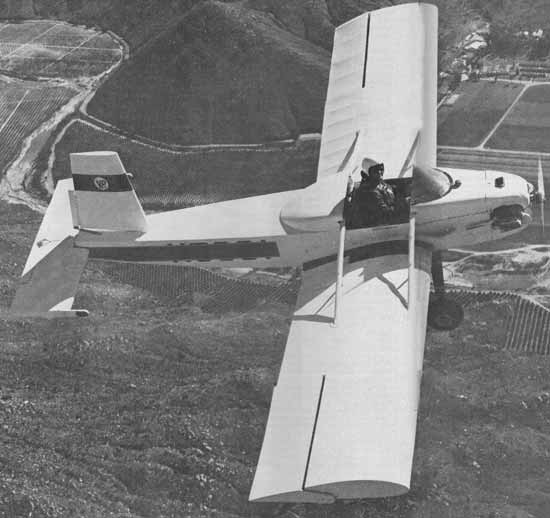
 |
Bud Evan's Volksplane II |
A Plane for the
Common Volks |
The Evans Volksplane was an attempt
to give homebuilders an airplane that was dirt simple and incredibly
cheap. It was professionally engineered by Bud Evan's a Convair engineer
and succeed at reaching all of its goals. Today, either the I or
the II would be great LSA projects. All right, maybe the Volksplane VP-II doesn't fit into the superplane category, but it wasn't supposed to. Its designer, W. S. "Bud" Evans, conceived the Volksplane for fun and frivolity, and to get pilots off the ground in the simplest, quickest and safest way possible. Considering those goals, I'd have to say he's succeeded in spades. As much as I've resisted Volksplanes in favor of the sleek and beautiful, I have to admit that there is probably not another airplane in the EAA menagerie that is so simple, yet so completely and professionally engineered and analyzed. At the same time, it manages to combine adequate sport-flyer performance with landing and takeoff characteristics that are so good the pilot shouldn't be allowed to count the landings as flight time. During my brief flight in the VP-II, I had to consider that I was seeing a Volksplane in the worst possible situation. For one thing, I was flying a two-place VP rather than a single-place, and my partner for the breezy ride was Bill Beatty, who, combined with my own heft and 14 gallons of gas, put us nearly 50 pounds over gross. And, the engine wasn't as large as Evans likes to see in this airplane. It was only a 2000cc Revmaster VW conversion, as opposed to the 2100cc it should have had. The week before, I had to plead with Evans to post-pone disassembling the airplane for a general cleanup and modification stint in his garage. The airplane had been sitting out at Ramona for two years, alternately baked and frozen by the inland California weather, and it was beginning to look a little dog-eared. I could have flown a single-place VP-I with a big engine, or Evans' own airplane (solo) and I'm certain I would have been much more excited and pleased with its performance. But, I wanted to play with the bottom edge of a Volks' personality and see what it was like when it didn't have things its way. Then I'd know that every VP around was at least as good as, and probably better than, the one I'd flown.
I don't know the exact circumstances that led to the team effort that sired the original VP-I, but it must have been the result of a bunch of Convair design engineers sitting around sipping suds and grousing about slaving all day for designs that were too complex to fly. So, Evans put clean paper on his drawing board, muttering, "Keep it simple, keep it simple," over and over as he designed a new low in aerial transportation. The original group of slide rule buddies pitched in: Bill Beatty, Walt Mooney and Charlie Ackerman (who did the engine conversion on the original 1200cc VW) combined with Evans to apply over 100 years of education and aircraft design experience among them. It's impressive, when you see the boxlike lines and Spartan features of the VP next to any other airplane, to think how much brain power it took to reduce aerodynamics and structures to the lowest common denominator. And don't underestimate the comfort and confidence it gives to look out at the picnic-table wings and cubic fuselage and know their ancestry is second to none. An F-102 had no finer engineering support. When you start poking around inside of a Volksplane, it's hard to believe that graduates of MIT and NYU were among those responsible for what is considered a minimum in structure. It takes a pro to work that close to the edge, though, and still know when he has plenty of safety built in. The VP-I, as spindly as it appears, is designed to meet the requirement for Utility category operation (4.4 G plus and 2.2 G negative). Flown solo, the VP-II has the same strength, but dual it's designed for Normal category, which is 3.8 positive and 1.9 negative. If my mother had asked me to build a box to hold her best crosscountry skis, the result would have probably been something very close to the VP fuselage. There's practically nothing to it but the plywood skins, three bulkheads and long longerons. There are no metal fittings and only one pulley (but no pulley bracket). The only welding in the entire airplane is in the control stick, wing struts and elevator horn, and even at today's rates that can't cost much more than $20, or a case of Coors, at your local welding emporium. There isn't even a motormount. The VW engine bolts directly to the firewall. The wings make the fuselage look complicated. If you've ever built a model airplane—the kind with silkspan-covered wings—you've built a miniature VP. All the ribs are stacked and bandsawed at one time out of 1/4-inch marine plywood, and the spars are planks, just regular old boards of aircraft quality spruce. No taper, no bevel, just a couple of holes. The drag and anti-drag wires attach to the spars with flat metal plates bent to the correct angle, and the compression members that keep the two spars apart are nothing but birch dowels from your local lumber yard. |